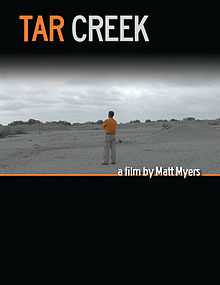Tar Creek (film)
| Tar Creek | |
|---|---|
 | |
| Directed by | Matt Myers |
| Produced by | Tanya Beer, Ron & Cara Beer |
| Written by | Matt Myers |
| Narrated by | Matt Myers |
| Music by | Watermelon Slim |
| Cinematography | Robert Billings |
Running time | 73 minutes |
| Country | United States |
| Language | English |
Tar Creek is a feature-length environmental documentary about the Tar Creek Superfund Site, which at one time was considered the worst environmental disaster in the United States. The land within the perimeters of this environmental disaster was bad enough that the federal government bought out the homes of citizens living there and moved them away. This documentary chronicles the long-term effects of mining, tribal relations, United States Environmental Protection Agency management, and ultimately concludes that environmental problems are human problems.
Synopsis
In the early part of the 20th century, drillers seeking a new fresh water well in northern Oklahoma found something considered more valuable than water: Lead. What eventually became known as the "Tar Creek" site was home to the world's largest strikes of heavy metals; in the period between and including the two World Wars, what was then known as the "Picher/Cardin Field", part of the Tri-State district mines in the central United States, produced over one-third of the world's total mined supplies of lead, zinc, and cadmium. The metals were so valuable that the area was deemed a vital U.S. resource, and the U.S. Government at one point subsidized the mining companies so that heavy metal extraction could continue from the increasingly less valuable rock, producing an ever-increasing amount of tailings. According to the former Environmental Impacts Liaison of the Quapaw Native American tribe, the rock from the main extraction point of the Picher/Cardin Field at one point was over one mile in height, visible from Main Street in the nearby city of Miami, Oklahoma.
As a result of the extraction process from hard rock mining, piles of tailings, known as "chat", were deposited all over the area, including on private property, where homeowners often used them for gravel and sand applications. However, due to the imprecise nature of extraction, the gravel-textured tailings contains dangerous levels of heavy metals, and the sand-like tailings (so-called "fines") contain even higher levels of metals, often thousands of times higher than the gravel chat. The "fines", because of their lighter nature, cause even greater danger due to their ability to be carried by the wind as well as being more capable of inhalation and accidental ingestion by animals and young children. Children under the age of six are considered at the greatest risk of neurological damage from lead poisoning, because their GI tracts are capable of more absorption than older children and adults. In a 1989 state of Oklahoma study of households in the Picher/Cardin area with children in this critical age range, 43% of the children were found to have elevated levels of lead in their bloodstream, as well as lead stores in their bones. This study was conducted nearly ten years after the site had been deemed the number one most contaminated site on the Superfund list. On the Superfund list, the site was now designated as the "Tar Creek Superfund site", named after the body of water that carried contaminates downstream from Picher/Cardin into the Grand Lake o' the Cherokees water system.
Now officially designated as America's worst environmental disaster, acid mine water in the creeks, stratospheric lead poisoning in the children, and sinkholes from severe undermining of the hard rock base upon which Picher and Cardin sit have caused the U.S. Government to officially declare the entire region uninhabitable, and the majority of residents have been bought out by the U.S. Government. However, this area is also officially designated by the Bureau of Indian Affairs as the tribal lands for the Quapaw tribe, and they are not eligible to be bought out or moved.
The producers of Tar Creek summarize the situation thusly:
The Tar Creek area is the stuff of science fiction. Except Tar Creek is centered around Picher, Oklahoma, America's Heartland. And it might be the one place in the States where you'd swear you stepped into a third world country. It’s so bad here that the federal government is buying everyone’s homes and moving them out. At least they are trying to. Corruption from Senator Jim Inhofe's office on down to the local Trust in charge of the buyout has forced some to remain because they can't afford to move. This land belongs to the Quapaw Tribe, and the Tribe will be handed back the worst Superfund site in the country after the government moves everyone away. Worse still, the Bureau of Indian Affairs made the mining companies leave all of this lead-laced waste rock on their land—75 million tons of it—which has caused this pandemic lead poisoning. For over 100 years, the government has been controlling Tar Creek, from Indian Removal to subsidizing wartime mining to 200 million in cleanup funds to the eventual buyout of families. And the reason why these people were kept here for so long is one of the oldest and ugliest of our own legacy.
Superfund screening tour
Starting in August 2010, Film Sprout began a nationwide outreach screening campaign designed to screen Tar Creek close to as many Superfund Sites as possible. This campaign is the first of its kind and was designed to help the citizens living in or around the nation's environmental problems to intelligently insert themselves into the Superfund process.